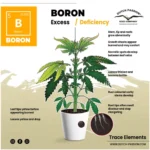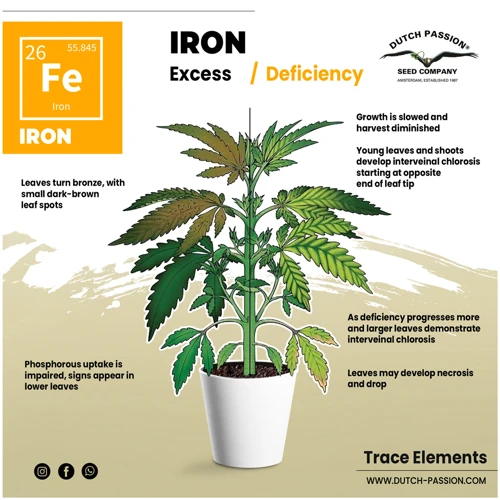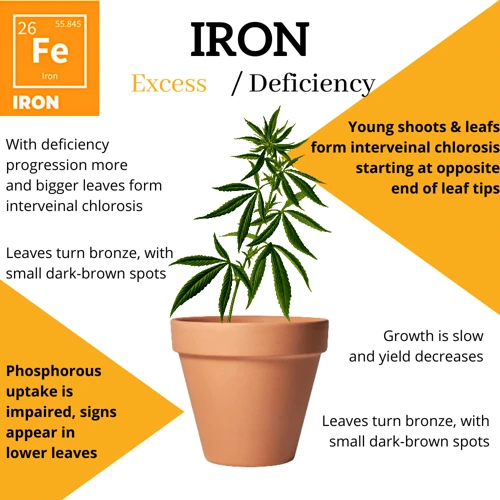
Iron and Your Cannabis Plants: What You Need to Know
As a cannabis cultivator, there’s nothing more frustrating than watching your plants struggle to grow and thrive. Even with careful attention to pruning, watering, and lighting, the health and vigor of your plants can still be impacted by a variety of factors. One of the most critical elements to consider is iron. But why is iron critical to cannabis plant growth, and how can you ensure that your plants are getting the right amount? In this article, we’ll take a close look at the role of iron in cannabis cultivation and strategies for addressing both iron deficiency and toxicity. So, let’s dive in!
Why is Iron Important for Cannabis Plants?
Contents
Iron is a crucial micronutrient for cannabis plants, playing a vital role in various physiological processes that contribute to plant growth and development. Without sufficient iron, cannabis plants can suffer from a range of issues that can stunt growth, reduce yield, and compromise plant health. In this section, we will explore the importance of iron for cannabis cultivation, delving into the critical functions of iron in plant metabolism and examining the signs of iron deficiency in cannabis plants.
The Function of Iron in Cannabis Plants
Iron is an essential micronutrient for cannabis plant growth and a key component in several important biological functions. Here are some of the key functions of iron in cannabis plants:
| Function | Description |
| Chlorophyll synthesis | Iron is required for the synthesis of chlorophyll, which is responsible for the plant’s green color and for capturing light energy during photosynthesis. |
| Electron transport chain | Iron is involved in the electron transport chain, which is responsible for generating energy for the plant’s metabolic processes. |
| Nitrogen fixation | Iron is required for the enzymes that are involved in nitrogen fixation, which is the process by which atmospheric nitrogen is converted into a form that can be used by plants. |
| Enzyme activation | Iron is involved in activating enzymes that are responsible for a range of metabolic processes in the plant, including respiration and DNA synthesis. |
Without adequate levels of iron, cannabis plants may exhibit stunted growth and reduced yields, as well as more serious issues such as chlorosis (yellowing of leaves) and necrosis (tissue death). As such, it is critical that growers maintain proper levels of iron in their nutrient solutions and soils to promote healthy cannabis plant growth.
Signs of Iron Deficiency in Cannabis Plants
Iron deficiency in cannabis plants is a common issue that can cause stunted growth and decreased yields. It is important to recognize the signs of iron deficiency in order to address the problem as soon as possible. Here are the main signs of iron deficiency in cannabis plants:
| Signs | Description |
|---|---|
| Pale Leaves | Iron deficiency causes leaves to turn yellow, with the veins remaining green. Over time, the leaves may become almost completely white. |
| Stunted Growth | Without enough iron, the plant will struggle to grow and may become stunted. It may also produce smaller leaves and buds. |
| Dry and Brittle Leaves | Iron deficiency can cause the leaves to dry out and become brittle. They may also curl up and fall off the plant. |
| Slowed Production | If iron deficiency goes untreated, the plant’s overall production will slow down. This can lead to decreased yields. |
If you notice any of these signs in your cannabis plants, it is important to take action to address the issue as soon as possible. Iron deficiency can significantly impact the health and yield of your plants, so it is important to act quickly to solve the problem.
Why Iron Deficiency is Common in Cannabis Plants
Iron deficiency is a common issue among cannabis plants, often causing stunted growth and yellowing leaves. There are several reasons for this, including:
- High pH levels: Iron is most readily available to cannabis plants when the soil pH is between 6.0 and 6.5. Soil with pH levels above 7.0 can make the iron less available to plants, leading to deficiency.
- Overwatering: Overwatering can lead to waterlogged soil, which limits oxygen availability to the roots. Iron uptake requires energy provided by oxygen, so deficient oxygen levels in the root zone can lead to iron deficiency.
- Underdeveloped root systems: Young and developing cannabis plants may not have well-developed root systems that can efficiently take up iron from the soil. This is especially true if the plant is grown in poor soil conditions with low iron content.
- Nutrient imbalances: Many nutrients interact with iron uptake, so deficiencies of other nutrients, such as manganese or zinc, can indirectly lead to iron deficiency.
- High levels of certain elements: Excessive levels of certain elements like calcium, potassium, or phosphorus can negatively affect iron uptake, leading to deficiency.
Understanding the reasons behind iron deficiency is crucial for cannabis growers to address the issue and ensure healthy plant growth. Removing these factors can help reduce the risk of iron deficiency and improve overall plant health.
How to Address Iron Deficiency in Cannabis Plants
As a cannabis cultivator, it can be frustrating to experience iron deficiency in your plants. Iron is a crucial nutrient for the growth and development of cannabis plants, and its deficiency can lead to stunted growth, yellowing leaves, and reduced yields. However, there are several ways to address and combat iron deficiency in cannabis plants. In this section, we will explore some effective techniques for increasing iron uptake and managing nutrient levels to maintain healthy and robust cannabis plants. Let’s delve into the details and unlock the secrets to addressing iron deficiency in your cannabis cultivation.
Increasing Iron Uptake in Cannabis Plants
Iron deficiency in cannabis plants can be a headache for growers. Hence, increasing iron uptake in cannabis plants can help prevent and cure iron deficiency. Here are some ways to increase iron uptake in cannabis plants:
- Lowering pH levels: Iron is better absorbed by cannabis plants in acidic soil conditions. Keeping the pH levels between 5.5 and 6.5 can help increase the availability of iron for uptake. However, extreme acidity can also have adverse effects on the plants.
- Foliar application: Spraying an iron solution on the leaves of the plants can increase iron uptake. However, this method is not recommended for flowering plants as it can affect the taste and aroma of the buds.
- Addition of organic matter: Adding organic matter like compost, manure, or worm castings can increase the availability of iron in the soil. Organic matter helps to chelate the iron, making it more accessible to the plants.
- Microbial inoculants: Using microbial inoculants like mycorrhizae and rhizobia can help improve iron uptake in cannabis plants. These microbes form a symbiotic relationship with the roots of the plants, increasing their nutrient absorption abilities.
Remember to monitor the plants when applying any of the above methods. Overuse can lead to iron toxicity, which can be just as harmful as iron deficiency.
Nutrient Management Techniques to Combat Iron Deficiency
When it comes to combating iron deficiency in cannabis plants, nutrient management techniques play a vital role. Here are some of the most effective techniques for managing iron deficiency in cannabis:
| Technique | Description |
|---|---|
| pH Balance Management | Iron deficiency in cannabis plants is often caused by pH imbalances in the soil. Managing the pH balance of the soil can help prevent and combat iron deficiency. The optimal pH range for cannabis plants is between 6.0 and 7.0. Cannabis cultivators can use pH meters or pH test strips to monitor the pH levels of the soil. |
| Iron Chelates | Iron chelates are a type of supplement that can be added to the soil to help increase iron uptake in cannabis plants. These supplements contain iron ions that are easily absorbed by the plants. Iron chelates can be added to the soil as a foliar spray or as a soil drench. |
| Organic Matter | Adding organic matter to the soil can also help combat iron deficiency in cannabis plants. Organic matter contains a variety of nutrients and minerals, including iron, that the plants can use. Some examples of organic matter that can be added to the soil include compost, manure, and worm castings. |
| Iron-Rich Fertilizers | Using iron-rich fertilizers is another effective way to combat iron deficiency in cannabis plants. These fertilizers typically contain a combination of nutrients, including iron, that can help boost plant growth and development. Some examples of iron-rich fertilizers include seaweed extract, blood meal, and fish emulsion. |
By utilizing these nutrient management techniques, cannabis cultivators can help prevent and combat iron deficiency in their plants, resulting in healthier, more productive yields.
Iron Toxicity in Cannabis Plants: Signs and Cures
Iron toxicity is another potential issue that can occur in cannabis plants. While iron is an essential micronutrient for plant growth, too much of it can have damaging effects.
Signs of Iron Toxicity in Cannabis Plants
One of the major signs of iron toxicity in cannabis plants is the yellowing of the leaves. However, this yellowing is different from the yellowing caused by iron deficiency. In the case of iron toxicity, the yellowing starts from the tips of leaves and moves towards the base. The leaves may also appear to be burnt at the edges, curling upwards and taking on a darker green hue.
Cures for Iron Toxicity in Cannabis Plants
If you suspect iron toxicity in your cannabis plants, there are a few ways to address the issue. First, consider that the issue may be caused by the use of too much fertilizer. Reduce fertilization and monitor your plants to see if this helps.
Another option is to flush your plants with pH-balanced water. This can help clear out excess iron and other nutrients that may be causing issues.
Lastly, consider using a chelated iron supplement in conjunction with a pH-balancing nutrient solution. Chelated iron is typically easier for plants to absorb and use, which can help avoid issues with overloading.
Conclusion
While iron toxicity is not as common as iron deficiency in cannabis plants, it is still a potential issue that cultivators should be aware of. Keep an eye out for yellowing leaves that start from the tips, as well as burnt-looking edges and curled leaves. If you suspect iron toxicity, reduce fertilization, flush your plants with pH-balanced water, and consider using a chelated iron supplement to help balance nutrient intake.
Conclusion
After learning about the crucial role that iron plays in the growth and development of cannabis plants, it is evident that it is a mineral that should not be overlooked. Iron deficiency is a common problem in cannabis cultivation, and it can lead to stunted growth, leaf yellowing, and significant plant losses.
However, addressing iron deficiency in cannabis plants is not as complicated as one might think. Simple solutions such as adjusting the pH levels of the soil, adding iron supplements or chelates, and practicing proper nutrient management techniques can go a long way in ensuring that your plants receive adequate amounts of this critical mineral.
It is also worth noting that while iron is essential to the growth of cannabis plants, too much of it can lead to toxicity. Therefore, it is essential to understand the signs and remedies of iron toxicity to avoid harming your plants.
Overall, a successful cannabis cultivation process depends on understanding the role of iron and other nutrients that are vital to plant development. By taking the necessary steps to ensure that your plants have access to essential minerals like iron, you can expect to achieve healthier and more abundant yields.
Frequently Asked Questions
What is the recommended iron concentration for cannabis plants?
The recommended iron concentration for cannabis plants is approximately 2-5 ppm.
What types of iron supplements are available to cannabis growers?
Chelated iron, iron sulfate, and iron chelate are common types of iron supplements available to cannabis growers.
Can iron deficiency be mistaken for a different nutrient deficiency?
Yes, iron deficiency can be mistaken for a magnesium or nitrogen deficiency. It is important to properly diagnose the deficiency before treating.
What pH level is optimal for iron uptake in cannabis plants?
The optimal pH level for iron uptake in cannabis plants is between 6.0 and 6.5.
What are some common symptoms of iron toxicity in cannabis plants?
Some common symptoms of iron toxicity in cannabis plants include brown or burnt-looking leaves, stunted growth, and reduced yield.
Can too much iron harm cannabis plants?
Yes, too much iron can harm cannabis plants by causing toxicity and hindering growth and yield.
How can growers prevent iron deficiencies in cannabis plants?
Growers can prevent iron deficiencies in cannabis plants by properly managing pH levels, using nutrient-rich soil, and implementing proper nutrient management techniques.
What types of soil are recommended for cannabis plants that require higher levels of iron?
Soils with a high level of clay content can hold onto more nutrients, including iron, and are recommended for cannabis plants that require higher levels of iron.
Can iron deficiency be caused by overwatering cannabis plants?
Yes, overwatering cannabis plants can lead to iron deficiency by limiting oxygen uptake in the roots and hindering nutrient absorption.
What are some common causes of iron toxicity in cannabis plants?
Common causes of iron toxicity in cannabis plants include over-fertilization, poor drainage, and using soil that is too rich in iron.




